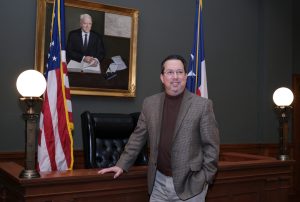
|
Only have a minute? Listen instead
Getting your Trinity Audio player ready...
|
A second causeway to South Padre Island was being talked about even before a barge struck Queen Isabella Causeway in the early morning hours of Sept. 15, 2001, causing two sections of the bridge to collapse and resulting in the deaths of eight people.
Now called the Queen Isabella Memorial Causeway, the span was already going on 30 years old at the time of the catastrophe. The collapse, occurring just four days after 9/11, added even greater urgency to the push for a second causeway. Nonetheless, scant progress was made in subsequent years, at least until Tuesday, when the Texas Transportation Commission added S.H. 104 — the future road comprising a second causeway — to the state highway system.
“The designation opens additional funding sources to accelerate development and construction of the new bridge and roadway, to be built between F.M. 106 and Park Road 100 on South Padre Island,” TxDOT announced.
Texas Transportation Commissioner Alex Meade described the commission’s action as “an important first step for the planning, development and construction of the second causeway project.”
“Like other projects around the state, if the second causeway project moves forward after the environmental review process it will require a significant partnership between TxDOT and local entities, including the (Cameron County Regional Mobility Authority) and the Rio Grande Valley (Metropolitan Planning Organization). Local partners will need to participate in providing significant local funding along with TxDOT funding to fund this project.”
Cameron County officials and TxDOT’s Pharr District requested the designation. According to the commission’s minute order ordering the designation, the commission found that “these actions will facilitate the flow of traffic, promote public safety, and maintain the continuity of the state highway system, and are necessary for the proper development and operation of the system.”
TxDOT noted that a second causeway “would also be beneficial for hurricane evacuations and emergency operations.” S.H. 104 would connect with F.M. 106 just south of the Port Isabel-Cameron County Airport, and connect with Park Road 100 on SPI approximately one mile north of County Beach Access No. 5.
Cameron County Judge Eddie Trevino Jr. said it’s not exaggerating to call the designation historic, and stressed that the county is fully prepared to cover its share of the cost in seeing the new causeway project through.
“We could not fund this project at the local level,” he said. “We’ve made it clear that whatever (TxDOT project) we’ve been involved in, we’ve got no problem putting in our local match, and we’re ready and excited to do that again for the second causeway down the road.”

The best estimate for the project, which will be done in phases, is more than $700 million, though the numbers could change, Trevino said.
He said that after being elected judge in 2016 the second causeway project became a major priority for him, though Trevino also recognized CCRMA Executive Director Pete Sepulveda Jr., who had been pushing for the project even longer.
“The one constant over the last 20 years is Pete Sepulveda, so I want to give him a lot of the credit because that’s where the credit is due,” Trevino said.
He likewise credited former Cameron County judge Gilberto Hinojosa and all previous county commissioners for their efforts.
“Commissioner (David) Garza has been on the commission since then,” Trevino said. “He obviously was a strong advocate.”
Receiving the commission’s designation for the project at long last is the result of the “confluence of everything going right at the same time, with the right people, in order to get things done,” he said.
“I think it’s been a meeting of the minds, and having the right leadership in all the (key) positions at the county and at the state level in order to get this project going,” Trevino said.
The merger of the Rio Grande Valley’s three metropolitan planning organizations, which occurred in 2019, had a lot to do with moving the project, as did the support of Gov. Greg Abbott, who encouraged the merger, and TxDOT Chairman Bruce Bugg, he said.
“I want to personally thank Gov. Abbott, and the members of the Transportation Commission along with TxDOT administration, our own Pharr District Office, and the entire Rio Grande Valley delegation in Austin,” Trevino said.
Having Meade appointed as one of just five TxDOT commissioners statewide was “the last piece of the puzzle,” he added.
“He’s done a very important and critical job in a very short period of time helping advocate for this project,” Trevino said.
CCRMA is preparing the environmental document for the project that will be reviewed by TxDOT, which said environmental clearance for the project is expected by fall 2026.



